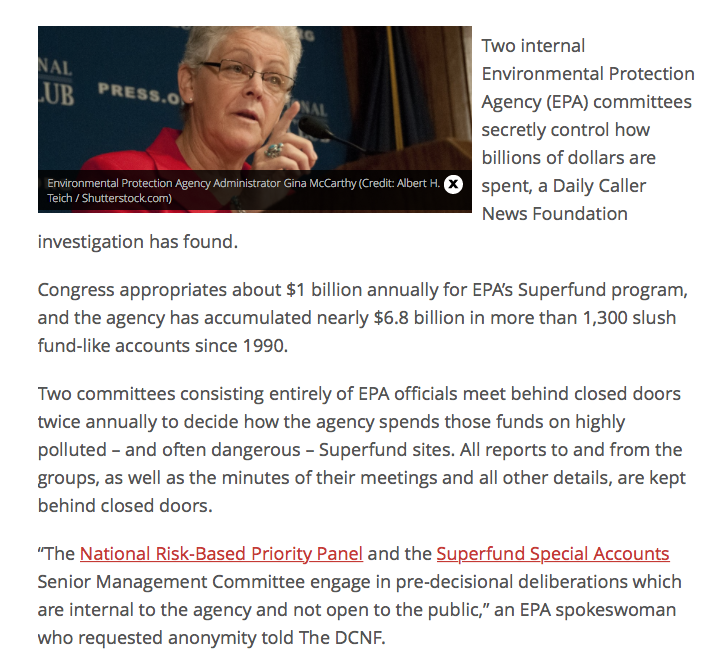The EPA’s Superfund is a public works program built on scientific fraud.
From the Daily Caller:
Below is a 1995 Wall Street Journal editorial citing my study:
Real risk reform
Wall Street Journal, 18 Apr 1995
The GOP House left for recess congratulating itself on fulfilling its Contract With America, and now polls show that most voters approve of the broad outlines but are confused by the details. But ultimately voters will judge by results, and here details do make a difference. So much will depend on what the House actually passed, and what happens now that the “contract” bills are in the Senate.
A good litmus will be the fate of proposals for cost-benefit/risk-assessment legislation. Here the potential benefits of a get-tough approach are great indeed. Steve Milloy, a researcher at the National Environmental Policy Institute, is now conducting the first study of how much money real risk-assessment could save in just one program, Superfund. His preliminary conclusion? Superfund costs could be reduced by 60%. That’s 60% off the roughly $30 billion that government and industry have spent so far on this program, which has cleaned up only a small fraction of targeted waste sites.
The need for risk assessment is underscored by Harvard researcher John Graham, who estimates that proposed EPA rules on paper production will cost $1.9 million per life saved. By contrast, Mr. Graham estimates that cervical cancer screenings every four years are an efficient use of resources — they cost $10,000 per life saved. An estimate in the $1.9 million range means the proposals will actually cost lives, by reducing our economic well-being, which more than anything else accounts for public health advances such as clean air and sanitation. But bureaucrats will never willingly give up their paper programs even if the money could be better spent on, say, cancer screenings.
In fact, both Congress and the President have tried to force risk-assessment onto the agencies via a 1981 executive order and the 1969 National Environmental Policy Act — but with no luck. To alter that dynamic, Congress needs to pass risk-assessment legislation with two key components: First, a “lookback” provision so that sane risk-assessment standards can be applied to the myriad environmental statutes enacted in the past 25 years.
Second, companies must be able to sue effectively to get the feds to live up to these standards. The current legal standard favors the government; a court can only overrule an agency now if its actions are deemed “arbitrary and capricious.” For meaningful reform, the feds should be held to a higher standard, that there is “substantial evidence” behind its judgments.
How do the House and Senate risk-assessment bills measure up to these standards? Not very well. None of the bills have lookback or the higher legal standard. Instead, most of them focus on defining laborious public procedures that regulators must follow before issuing a ruling. Ensnaring bureaucrats in red tape isn’t a bad idea, but it’s doubtful that these measures will accomplish what their proponents claim.
The science behind risk-assessment is amorphous enough that, by putting political factors into the calculation, regulators can almost always come up with the results they want. The bills make this fairly easy to do by allowing EPA and other agencies to appoint their own “peer review” panels to examine their risk analyses. If these handpicked panels somehow decide that a proposal isn’t justified, the agency could simply ignore the scientists and proceed anyway.
That said, some of the proposed risk-assessment bills accomplish more than others. The House-passed bill does have judicial review and a “supermandate” provision that would subject new regulations issued under existing laws to the risk-assessment standards. So does a bill sponsored by Bob Dole in the Senate. With just a little strengthening, this could be the basis for a truly revolutionary approach to regulation. But the Dole bill so far remains mired by Democrats’ delaying tactics.
Meanwhile, opponents of the idea are rallying to a toothless measure sponsored by Republican Bill Roth. This measure lacks real judicial review and a “supermandate” requirement. No wonder a Natural Resources Defense Council official told the Washington Post “we’re encouraged” by this bill, while an EPA spokesman lauded it as “quite promising.” Republican Senators should realize that, while passing some version of the Roth bill is the path of least resistance, it’s worth suffering some short-term political pain to enact a tougher measure. Otherwise, voters will eventually see that despite claims of reform, runaway regulations remain as oppressive as ever.
The broad appeal of the “contract” lies in delivering what was promised. But if the details take back all the promises, voters will only be more frustrated and disillusioned than ever.
